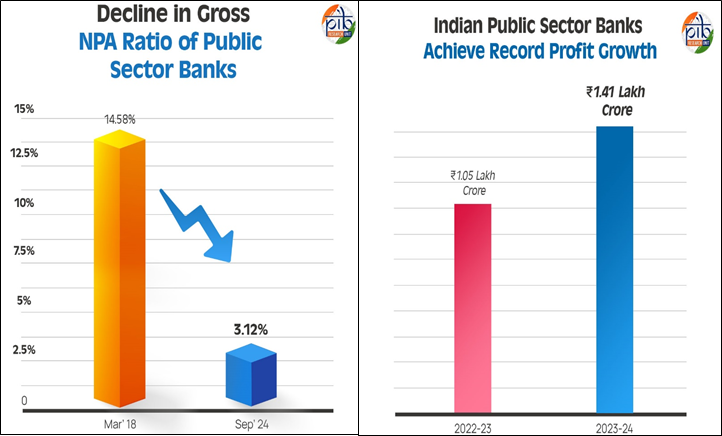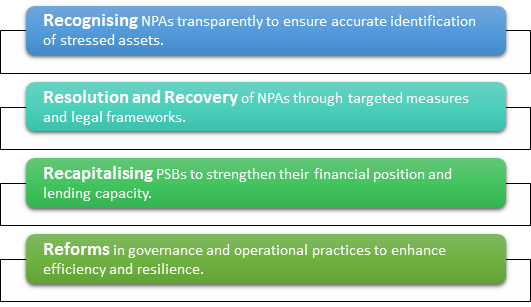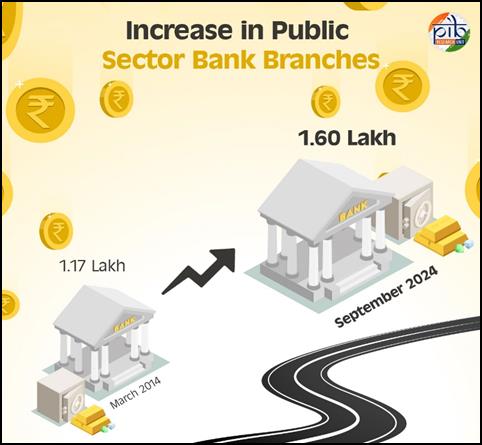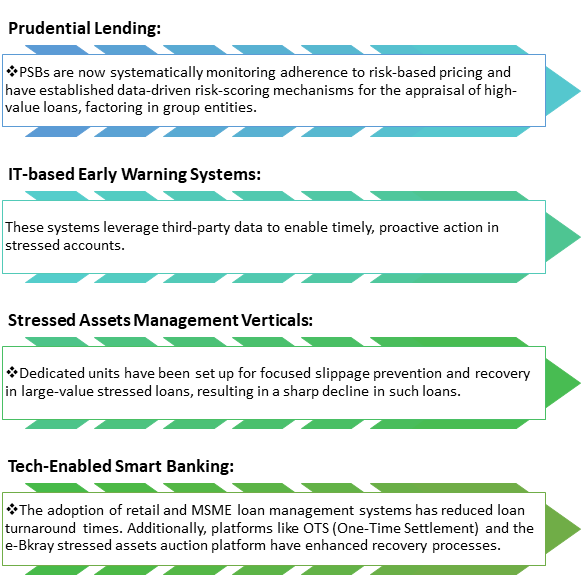Public Sector Banks: A Resurgent Force
Public Sector Banks: A Resurgent Force
Introduction
Public Sector Banks (PSBs) in India have achieved a remarkable milestone by recording their highest-ever aggregate net profit of ₹1.41 lakh crore in the financial year 2023-24. This landmark achievement reflects the sector’s robust turnaround, underpinned by a significant improvement in asset quality. The Gross Non-Performing Assets (GNPA) ratio steeply declined, dropping to 3.12% in September 2024. Demonstrating continued momentum, they registered a net profit of ₹ 85,5206,000 crore in the first half of 2024-25. In addition to their stellar performance, PSBs have contributed significantly to shareholder returns, paying a total dividend of ₹61,964 crore over the past three years. This remarkable financial growth underscores the sector’s operational efficiency, improved asset quality, and stronger capital base.

Beyond their financial achievements, these banks have played a key role in promoting financial inclusion. They have implemented crucial government schemes like the Atal Pension Yojana and Pradhan Mantri Jeevan Jyoti Bima Yojana, to name a few. These efforts have ensured that vital benefits reach underserved sections of society. The government of India has actively supported the sector with reforms, welfare measures, and strong policies. This has strengthened the banking system, fostering greater transparency, stability, and inclusivity.
Decline in GNPA: Strengthening PSB Resilience
The Gross NPA ratio of Public Sector Banks (PSBs) has witnessed a remarkable improvement, declining to 3.12% in September 2024 from a peak of 14.58% in March 2018. This significant reduction reflects the success of targeted interventions aimed at addressing stress within the banking system.
A turning point came in 2015 when the Reserve Bank of India (RBI) initiated the Asset Quality Review (AQR). This exercise aimed to identify and address hidden stress in banks by mandating the transparent recognition of NPAs. It also reclassified previously restructured loans as NPAs, resulting in a sharp increase in reported NPAs. The heightened provisioning requirements during this period impacted the financial parameters of banks, restricting their ability to lend and support productive sectors of the economy.
To address these challenges, the Government introduced a comprehensive 4R’s strategy:

Another indicator of the improved resilience of Public Sector Banks (PSBs) is their Capital to Risk (Weighted) Assets Ratio (CRAR), which rose by 3983 basis points to 15.43% in September 2024, up from 11.45% in March 2015. This substantial improvement not only highlights the renewed stability and robustness of India’s banking sector but also positions PSBs to better support economic growth. Notably, this CRAR far exceeds the Reserve Bank of India’s (RBI) minimum requirement of 11.5%, underscoring the strengthened financial health of these institutions.
Expanding Financial Inclusion
PSBs continue to expand their reach across the nation, deepening financial inclusion. Their strengthened capital base and improved asset quality have enabled them to access markets independently, reducing reliance on government recapitalisation.
Here’s how PSBsSCBs are deepening financial inclusion:

The Kisan Credit Card (KCC) Scheme aims to provide short-term crop loans to farmers. Total operative KCC accounts as of September 2024 stood at 7.71 crore with a total outstanding of Rs. 9.88 lakh crore.
Strengthening PSBs through EASE Framework
The Government has implemented a series of measures to enhance the financial condition of Public Sector Banks (PSBs) through the Enhanced Access & Service Excellence (EASE) framework. This framework institutionalises an objective process of incremental reforms aligned with the evolving banking ecosystem, focusing on governance, prudent lending, risk management, technology- and data-driven banking, and outcome-centric human resources.
Key highlights of the steps taken under EASE to strengthen the financial condition of PSBs include:

Conclusion
Public Sector Banks in India have made remarkable strides in recent years, achieving unprecedented financial milestones and contributing significantly to the nation’s economic stability and growth. The decline in Gross Non-Performing Assets (GNPA) and improved Capital to Risk (Weighted) Assets Ratio (CRAR) reflect the sector’s resilience and sound risk management practices. The EASE framework has been crucial in institutionalising reforms, promoting prudent lending, and leveraging technology for better banking services. The focus on financial inclusion has expanded access to banking, empowering millions with affordable credit and insurance. With a stronger financial base and improved asset quality, PSBs are well-positioned to support India’s development agenda and drive inclusive economic growth.
References: